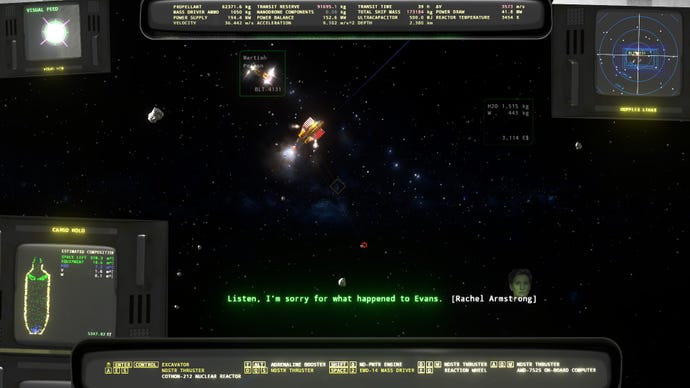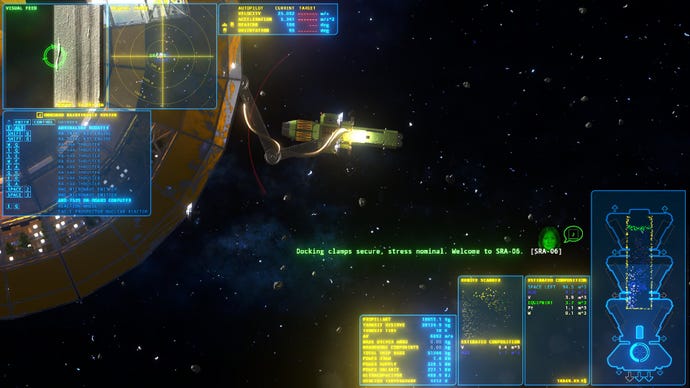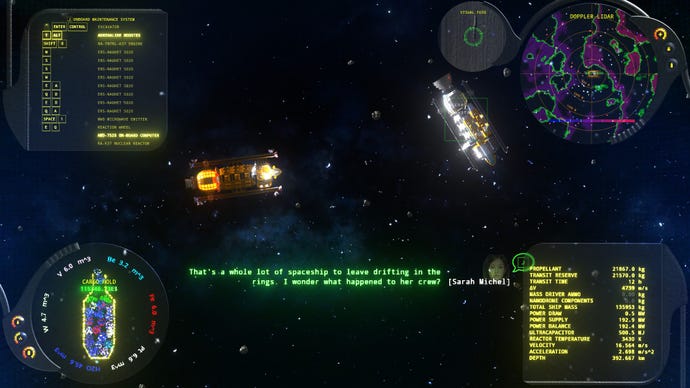I can’t remember the last time I struggled so hard to finish a game.
You misunderstood. I’m not saying ΔV: Rings Of Saturn is a chore or a chore. I found it difficult because every time I start it I can get lost for hours playing he. Not trying to win, not following the story, not looking for (ugh) “progress”. Just exploit, explore, drift lazily in the void. It’s a game that I don’t want to exhaust because I enjoy it too much. I went back into “for a quick dive” twice during this intro.
It has no content. It’s not one of those compulsive, manipulative games forever. You could skim through it efficiently, probably finding all of its secrets and items as quickly as possible. That wouldn’t be wrong, exactly, but it misses the point: it’s a game to be savored, not consumed.
This is partly because of its narrow focus. You’re free to develop your own style, philosophy, and methods, but Triangle Vee Colon Rings is all about finding and mining minerals in a detailed 2D physics simulation. It sounds dry and boring, but just as an open-world game can become sublime by making travel enjoyable, the part of space games that I usually avoid completely can become sublime by making even the most mundane work challenging and satisfying.
You’re a ring miner, commanding a bulky vessel that’s little more than a glorified bucket, built for one thing: to dive anywhere within Saturn’s titular rings. Deeper dives take more time and fuel to recover, and are riskier, as friendly miners become rarer than outlaws with secrets and radical ideas, some of whom once called me “collaborator”.
So you’ll stick to shallow waters at first, whenever you want an easy ride or to test out a new setup. There are more sophisticated ships and loads of equipment options, but many are sidegrades. The fundamentals are to smash open asteroids with a mass conductor, then push and grab them into the cargo hold – and knock them over again if you brake before it closes. Save and you can microwave or laser open space rocks (invisible until they intersect with a resulting vapor cloud). Scavenger drones and an attaching manipulator arm can be fitted to pull ores towards you, but even these are just aids. It’s not an upgrade, it’s just another option, because they all work imperfectly. Your tools work with you, not for you.
You might think sticking mostly to the humble starter ship is my usual stubborn flint axe-wielding, never seen map in Skyrim, but that’s not the case. The ship that works for you is the best ship. Gear that you like the feel of is the best gear. The way you like to mine, or avoid mining for its few secondary activities, is the best way to mine. Or, uh, avoid.

There are secrets there. Abandoned ships, escape pods, pirates to be a space cop (which can be paid, some even explain their motivations). Your crew scans for ores, repairs and tracks ever-changing points of interest, and occasionally features a micro-story you can follow instead of just one main plot. There are tensions with unexplained anarchists, but these aren’t side quests waiting in a list, not knowledge waiting to be put on your wiki. Rings of Saturn is overwhelmingly about atmosphere.
Much of the gear can be modded, partly to take advantage of its physics simulation and cool tech systems, but also to experiment – to customize, not optimize. There are several installable HUDs above the boot one which boots on launch like an 80s computer, but is too busy for me. The OCP-209’s parts spin in place instead, but its circular cargo display and translucent sensor readouts are more stylish than functional – give me that opacity, damn it. Another reflects objects and wobbles when you turn too hard. Flashy fantasies are, well, they’re somebody’s thing.
“Your team scans for ores, repairs and tracks ever-changing points of interest, and occasionally features a micro-story you can follow instead of just one main plot”
An autopilot model that I enjoy only because its screen translates LIDAR readings into a circle that helps me differentiate rocks from derelict ships without taking my eyes off the direction. The cheaper models don’t have this, and the more expensive ones come with features I don’t need. This isn’t about the “level” bullshit that has plagued game design so much in recent years. This mid-level autopilot helps me locate drifting treasures, which don’t appear as icons but vague directions, which is why it’s so important to learn how to read the initially overwhelming readings. THE fantastic the music changes and the edges of the screen glow blue when something good is nearby, but “nearby” is a wide net in space, and you still have to follow what I imagine to be a crewman’s hunch about a weird sensor reading to actually find it. The edges also glow red when there’s danger…or when you’re flying backwards at 105m/s through a dense asteroid field and the rock music starts playing and you take your hand off the controls to revel in it, you maniac.




NPC ships don’t make noise unless they hit you with something. The crew will exchange vague, private messages with the ships you greet (repeating some lines too often, unfortunately). A pilot smuggled a cat on board. I salvaged a ship with a set of RA-K44 thrusters and dual microwave beams, which turned out to be so powerful that it was impossible to operate them because I couldn’t hold the damn thing steady. Despite its realistic physics and intimidating numbers, much of Rings resembles a ship. You don’t calculate; you lead. You don’t automate the basics, you choose the aids you like
As a result, it doesn’t hit me with grinder remorse like a Minecraft. I don’t hoard money for fun, I try out different ship and gear configurations, search for wrecks, greet strangers in hopes they reveal something interesting, and enjoy dives for themselves, then stop when I’ve had enough. A dive might mean a mini-adventure or a spooky encounter, but it’s more likely to be a laid-back forty minutes of manual drifting and leisurely ore-gathering punctuated by a few panicky near-misses when my carefree habits pay off like they did in Hardspace Colon Shipbreaker, its friendly cousin. There are other things to do, but the heart of it is visiting the spectacular, desolate depths of space and reveling in sci-fi machines doing this incredibly mundane thing. It won’t be for everyone for that reason. But like its realistic lasers, it’s expertly calibrated to strike those of us in its niche straight through the heart.
This review is based on a review version of the game provided by publisher Kodera Software and Kurki.games.


